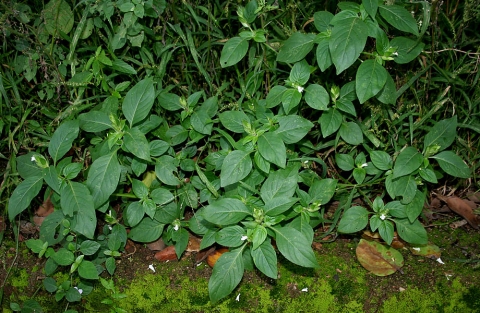Asystasia mysorensis
(Roth) T.Anderson
Acanthaceae
The name of this species is sometimes mis-spelled Asystasia mysurensis, based on its publication in Journal of the Linnean Society, Botany 9: 524. 1867. However, this name is based on the earlier publication of Ruellia mysorensis in Novae Plantarum Species 303. 1821, and is either a mis-reading or a mis-spelling of that name[
K- Title
- Plants for a Future
- Author
- Ken Fern
- Description
- Notes from observations, tasting etc at Plants For A Future and on field trips.
].
Adhatoda rostellaria humilis Nees
Adhatoda rostrata Hochst. ex Oliv.
Asystasia rostrata Solms
Asystasia schimperi T.Anderson
Ruellia mysorensis Roth
Common Name:

Plant growing in native habitat in Andhra Pradesh, India
Photograph by: J.M.Garg

General Information
Asystasia mysurensis is an annual plant that starts off growing erect but later scrambles on the ground[
398- Title
- Edible Wild Plants of Tanzania
- Publication
-
- Author
- Ruffo, C.K.: Birnie, A. & Tengnas, B.
- Publisher
- Regional Land Management Unit; Nairobi.
- Year
- 2002
- ISBN
- 9966-896-60-0
- Description
- A very well presented, simple guide to growing and utilizing wild food plants in Tanzania, with line drawings of each plant, a description, habitat and range, non-food as well as food uses, plus basic information on growing the plants.
].
The leaves are gathered from the wild for local consumption and are sometimes sold in local markets[
398- Title
- Edible Wild Plants of Tanzania
- Publication
-
- Author
- Ruffo, C.K.: Birnie, A. & Tengnas, B.
- Publisher
- Regional Land Management Unit; Nairobi.
- Year
- 2002
- ISBN
- 9966-896-60-0
- Description
- A very well presented, simple guide to growing and utilizing wild food plants in Tanzania, with line drawings of each plant, a description, habitat and range, non-food as well as food uses, plus basic information on growing the plants.
].
Known Hazards
None known
Botanical References
Range
Eastern and southern Africa - Ethiopia and Eritrea to Namibia and South Africa.
Habitat
Forest edges and thickets and in secondary regrowth after cultivation or other disturbance of the soil. Often a weed in arable land or along paths. Found at elevations up to 2,200 metres[
398- Title
- Edible Wild Plants of Tanzania
- Publication
-
- Author
- Ruffo, C.K.: Birnie, A. & Tengnas, B.
- Publisher
- Regional Land Management Unit; Nairobi.
- Year
- 2002
- ISBN
- 9966-896-60-0
- Description
- A very well presented, simple guide to growing and utilizing wild food plants in Tanzania, with line drawings of each plant, a description, habitat and range, non-food as well as food uses, plus basic information on growing the plants.
].
Properties
| Edibility Rating |    |
| Habit | Annual |
| Height | 1.00 m |
| Cultivation Status | Wild |
Cultivation Details
A plant of the tropics where it is found at elevations up to 2,200 metres. It grows in areas where the mean annual rainfall is in the range 1,000 - 2,100mm[
398- Title
- Edible Wild Plants of Tanzania
- Publication
-
- Author
- Ruffo, C.K.: Birnie, A. & Tengnas, B.
- Publisher
- Regional Land Management Unit; Nairobi.
- Year
- 2002
- ISBN
- 9966-896-60-0
- Description
- A very well presented, simple guide to growing and utilizing wild food plants in Tanzania, with line drawings of each plant, a description, habitat and range, non-food as well as food uses, plus basic information on growing the plants.
].
Tolerates a wide range of soils[
398- Title
- Edible Wild Plants of Tanzania
- Publication
-
- Author
- Ruffo, C.K.: Birnie, A. & Tengnas, B.
- Publisher
- Regional Land Management Unit; Nairobi.
- Year
- 2002
- ISBN
- 9966-896-60-0
- Description
- A very well presented, simple guide to growing and utilizing wild food plants in Tanzania, with line drawings of each plant, a description, habitat and range, non-food as well as food uses, plus basic information on growing the plants.
].
Edible Uses
Leaves and young shoots - cooked and eaten as a vegetable[
398- Title
- Edible Wild Plants of Tanzania
- Publication
-
- Author
- Ruffo, C.K.: Birnie, A. & Tengnas, B.
- Publisher
- Regional Land Management Unit; Nairobi.
- Year
- 2002
- ISBN
- 9966-896-60-0
- Description
- A very well presented, simple guide to growing and utilizing wild food plants in Tanzania, with line drawings of each plant, a description, habitat and range, non-food as well as food uses, plus basic information on growing the plants.
]. They are collected, boiled alone or mixed with other vegetables such as cowpeas or mnavu (Solanum nigrum). The leaves can also be mixed with tomatoes, onions, coconut milk, pounded oyster nuts (Telfairia pedata) or groundnuts and served with a staple food such as ugali, rice, bananas or potatoes[
398- Title
- Edible Wild Plants of Tanzania
- Publication
-
- Author
- Ruffo, C.K.: Birnie, A. & Tengnas, B.
- Publisher
- Regional Land Management Unit; Nairobi.
- Year
- 2002
- ISBN
- 9966-896-60-0
- Description
- A very well presented, simple guide to growing and utilizing wild food plants in Tanzania, with line drawings of each plant, a description, habitat and range, non-food as well as food uses, plus basic information on growing the plants.
].
Medicinal
None known
Other Uses
None known
Propagation
Seed -
If you have any useful information about this plant, please leave a comment. Comments have to be approved before they are shown here.
 Useful Tropical Plants Database 2014 by
Ken Fern,
web interface by
Ajna Fern
with help from
Richard Morris.
Useful Tropical Plants Database 2014 by
Ken Fern,
web interface by
Ajna Fern
with help from
Richard Morris.